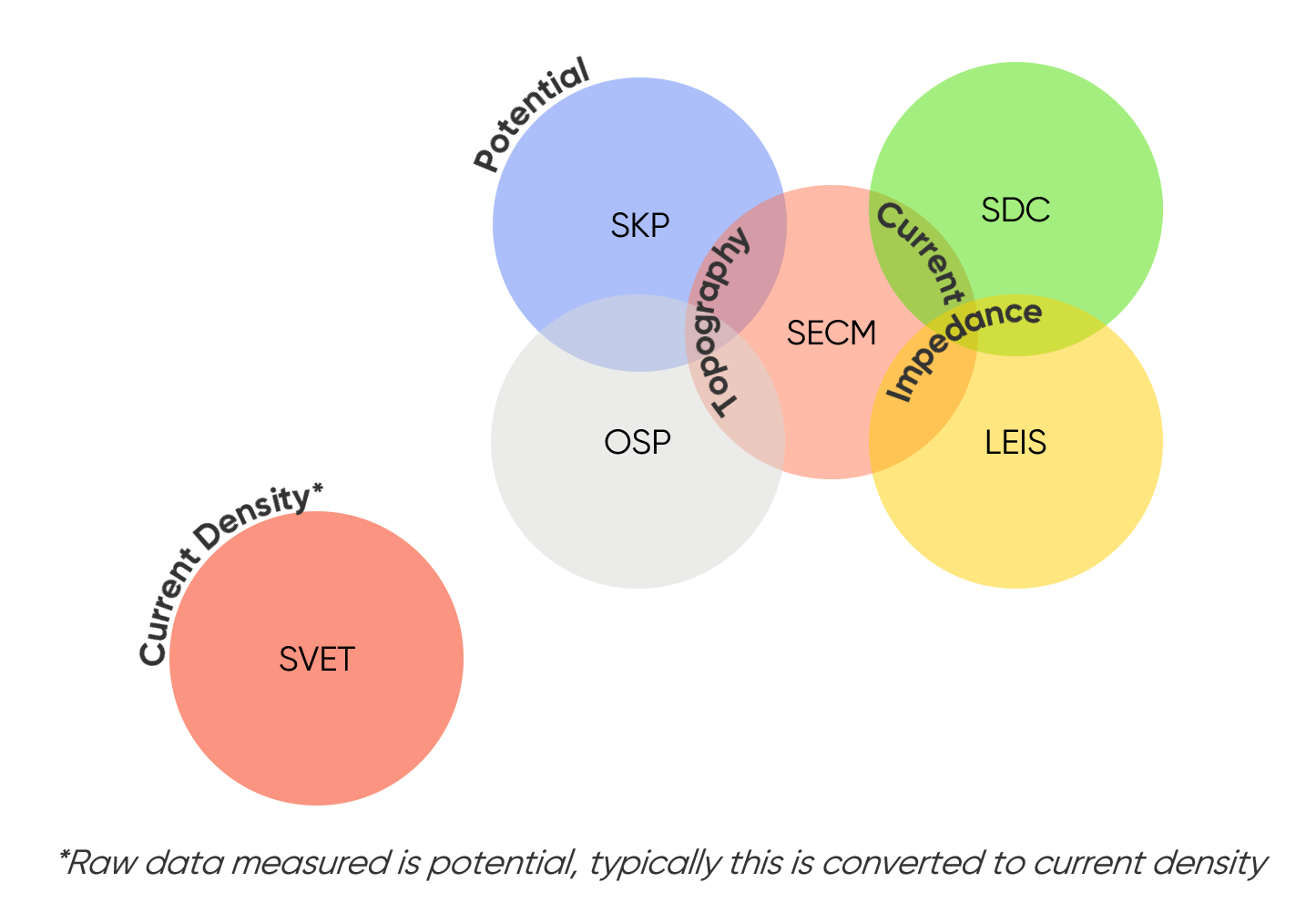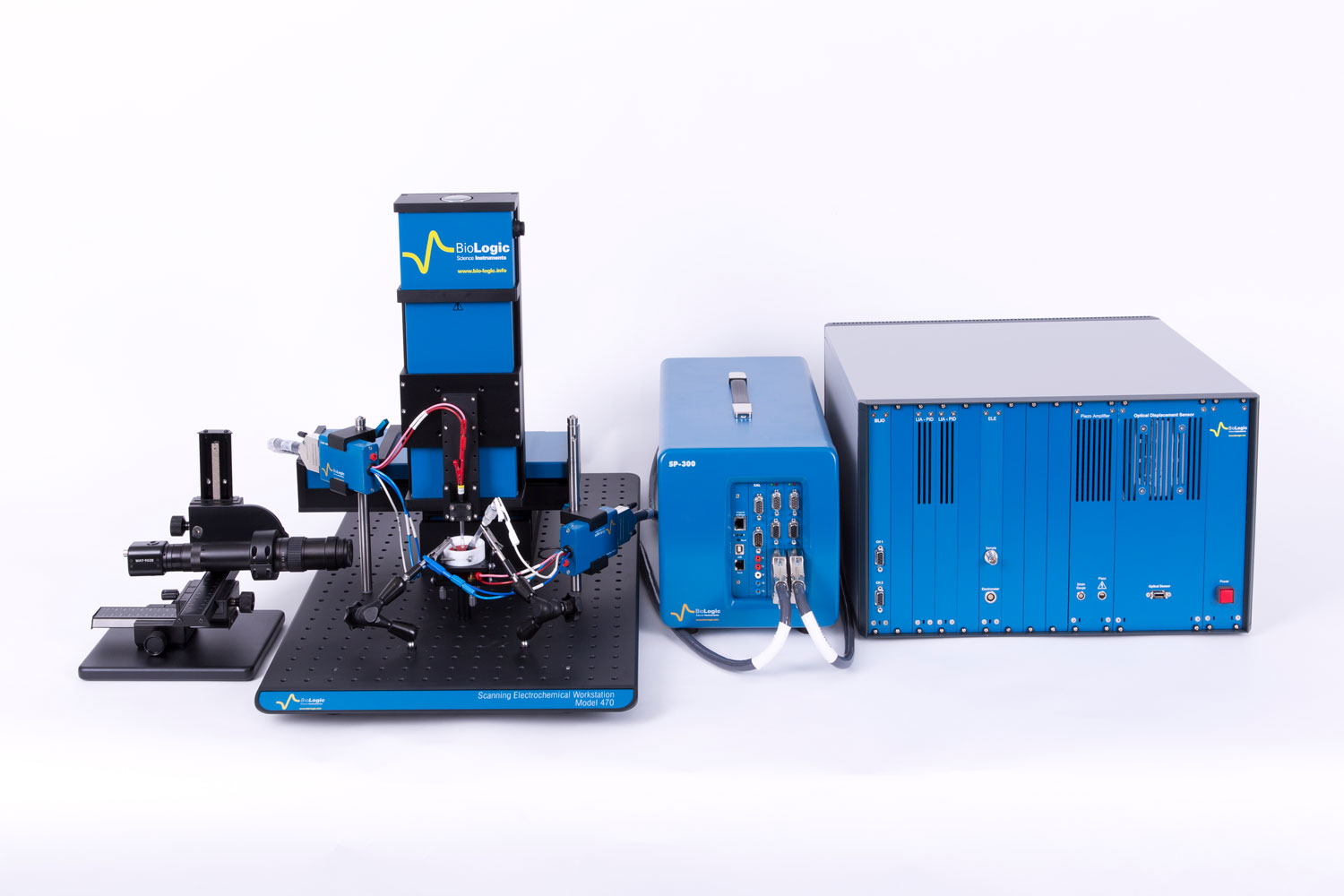Scanning Probe Electrochemistry & BioLogic
BioLogic M470: A versatile, high-performance Scanning Electrochemical Workstation
Scanning probe electrochemistry encompasses a range of scientific techniques combining both electrochemistry and microscopy. Bulk electrochemistry allows the investigation of global processes; however, it does not necessarily indicate the cause of such bulk processes. Conversely, with microscopy, surface features can be measured, but the effect of these features is not clear. Scanning probe electrochemistry gives users a “best of both worlds” approach locally mapping the electrochemistry of a sample. Through scanning probe electrochemistry, a correlation between activity and features can be made. Scanning probe electrochemistry includes:
- Scanning Electrochemical Microscopy (SECM)
- Localized Electrochemical Impedance Spectroscopy (LEIS)
- Scanning Vibrating Electrode Technique (SVET) (also known as vibrating probe)
- Scanning Kelvin Probe (SKP)
- Scanning Droplet Cell (SDC)
BioLogic has over 25 years of experience producing scanning probe electrochemistry instruments. Initially, this included a number of single technique instruments, with the first-ever modular scanning electrochemical workstation, the M370, introduced in 2006, under the Uniscan name.
Scanning probe electrochemistry has found use in academic and commercial research settings. It is applicable in any field in which bulk electrochemical measurements have been used. Scanning probe electrochemistry has found widespread use in:
- Corrosion and coatings
- Biology, including biosensors and biotechnology
- Batteries, fuel cells, and photovoltaics
- Materials
- Catalysis
- Sensors

For more information on the different factors you should take into account when purchasing a scanning electrochemical workstation please see our learning center article “Key factors to consider when looking for a scanning electrochemical workstation“
M470 Scanning Electrochemical Workstation
BioLogic’s M470 Scanning Electrochemical Workstation gives users the highest level of flexibility available in scanning probe electrochemistry. There are 9 different techniques available on this fully modular instrument which can be included at the point of purchase or added as the researcher’s needs grow. The wide range of cells and probes available for the M470 ensure that this scanning electrochemical workstation can be constantly tailored to meet experimental needs. Furthermore, the M470 is the only commercial scanning electrochemical workstation offering Intermittent Contact-SECM (ic-SECM) for constant distance SECM measurements. In this, the latest generation of scanning electrochemical workstations, all of the necessary electronics are contained within a single control unit, taking up the smallest possible amount of space.
Related product
Why BioLogic Scanning Electrochemical Workstations stand out? What makes the M470 different?
Centralized, easy-to-use software. All your M470 scanning probe electrochemistry techniques are powered by one easy-to-use control interface
The nature of local electrochemistry, which exploits a large number of electrochemistry techniques (the M470 can be fitted with seven techniques: SECM, OSP, SKP, IC-SECM, SDS, SVP) means that unless the scanning electrochemical workstation control software has been specifically designed to manage all these techniques it can be very difficult for users to plan experiments.
Many scanning electrochemical workstations require users to use different control software packages for each technique. This can make setting up and running experiments difficult and requires additional user effort and can slow down your workflow. By keeping “everything under the same roof” with one universal control interface, the M470’s scanning electrochemical workstation software allows the user to easily set up all experiment types including electrochemistry, electrochemical impedance spectroscopy (EIS), and scanning experiments.
Make it simple. Make it work together: A unified approach to scanning electrochemical workstation design
Some scanning electrochemical workstations are built using outsourced components that have not been specifically designed for the instrument or the technique. This can sometimes create issues with product installation, especially product support. The M470 scanning electrochemical workstation is the product of years of research and development. This experience has helped BioLogic design electronic components purpose-built for scanning probe electrochemistry. All of these components are contained within a single control unit. And because all connections are made internally there’s no room for human error during experiment setup. So users don’t need to worry about faulty connections and can concentrate on learning their techniques!
Enclosed axes: choose a scanning electrochemical workstation that does not attract dust and dirt
Dust and dirt are the enemies of most scientific instruments, but especially scanning-electrochemical workstations. Some scanning electrochemical workstations do not enclose the positioning system, making it a magnet for dust and dirt, which can send the instrument into an error state as well as require regular cleaning and maintenance. The M470 scanning electrochemical workstation axes are almost fully enclosed. This protects the positioning system from dust and dirt. So users can exploit an instrument that is not just high-accuracy and high-performance but one that minimizes maintenance.
I need support! Where do I go?
BioLogic has invested heavily in online and offline support. So, if you have a problem, we can help you find a solution. Our ever-growing back-catalog of technical notes and application notes is complemented by short, easy-to-read articles in our Learning Center. We are sure that you will find the information that you need online. But if you do need to talk to someone, our global support network means that there will always be someone to advise you if you need help.
Find out more about Scanning Probe Electrochemistry on BioLogic's Learning Center
BioLogic’s Learning Center is a scientific blog covering every aspect of local electrochemistry, including experiment setups, tech-tips, theory as well as background scientific information. The Learning Center is updated regularly with new articles related to scanning probe electrochemistry so check back regularly.
| Energy Storage & Conversion | Research Electrochemistry | Life sciences | Materials science |
| SECM 101: Introduction to the redox mediator The article explains the importance of the redox mediator in scanning probe electrochemistry | SECM 101: Introduction to the redox mediator The article explains the importance of the redox mediator in local electrochemistry | SECM 101: Introduction to the redox mediator The importance of the redox mediator in local electrochemistry | SECM 101: Introduction to the redox mediator Why the redox mediator is important in local electrochemistry |
| OSP101: Introduction to the Optical Surface Profiler technique The components of an optical surface profiler and its role in scanning probe electrochemistry | OSP101: Introduction to the Optical Surface Profiler technique The components of OSP and its role in scanning probe electrochemistry | OSP101: Introduction to the Optical Surface Profiler technique The different components of the optical surface profiler and the role of the OSP role in local electrochemistry | OSP101: Introduction to the Optical Surface Profiler technique The components of an optical surface profiler and its role in scanning probe electrochemistry |
| Anatomy of an SKP probe The key components of the probe which define the quality of scanning probe electrochemistry measurement | Anatomy of an SKP probe The key components of the SKP probe which define the quality of local electrochemistry measurements | Scanning probe electrochemistry for biological research The article outlines the benefits of Scanning probe electrochemistry for biological studies. the article includes vibrating probe and SECM techniques | SKP and the Fringing Effect Understanding the fringing effect and its role in Scanning Kelvin Probe (SKP) |
| SKP and the Fringing Effect Understanding the fringing effect and its role in Scanning Kelvin Probe (SKP) | SKP and the Fringing Effect Understanding the fringing effect and its role in the local Scanning Kelvin Probe (SKP) technique | Scanning probe electrochemistry & biology research The role of scanning probe electrochemistry in biological systems inculding dc-SECM, ac-SECM; skp and vibrating probe local electrochemistry techniques | Scanning probe electrochemistry for materials research Scanning Electrochemical Microscopy and Scanning Kelvin Probe are useful local electrochemistry techniques in materials research. But how do they help? |
| Scanning probe electrochemistry for catalysis research An overview of the benefits of local electrochemistry in catalysis research | Scanning probe electrochemistry for sensor research Overview of the application of local electrochemical techniques in sensor research: Electrochemical Microscopy (SECM), & Scanning Kelvin Probe (SKP) | Imaging the electrochemistry of photosynthesis How is scanning probe electrochemistry applied to the investigation of photosynthesis? This Learning Center article tells all. | Scanning Probe Electrochemistry & Materials Research The use of scanning probe electrochemistry in materials science |
| Scanning probe electrochemistry for sustainable energy research Scanning Electrochemical Microscopy, Scanning Kelvin Probe, Scanning Vibrating Electrode Technique are key tools in sustainable energy research. But how? | LEIS or ac-SECM?An article detailiing the merits of the LEIS and acSECM local electrochemistry techniques | Probing 2D Materials 2D materials have been investigated using traditional electrochemical methods, providing a global view of the 2D material under investigation. |
|
| Scanning Probes & Fuel Cell Research This article in BioLogic's learning center gives an overview of for Scanning Probe techniques suitable for Fuel Cell Research | Scanning probe electrochemistry for catalysis research An overview of the benefits of local electrochemistry in catalysis research | ||
| A bright idea: Scanning Kelvin Probe (SKP) for the investigation of photovoltaic systems Article details the importance of accurately measuring the work function of device components, especially electrodes in relation to photovoltaic technology | Coatings, Corrosion and Scanning Probe Electrochemistry A short video presentation of the benefits of scanning probe electrochemistry for the coatings and corrosion application. | ||
| Scanning Probes & Photovoltaic Research The importance of Scanning probe electrochemistry in Photovoltaic research. How a local approach to electrochemistry can help PV research | SDC101: An Introduction to Scanning Droplet Cell Introduction to the Scanning Droplet Cell technique one of the 7 local electrochemistry techniques available with the M470 scanning electrochemical workstation | ||
| Scanning probe Electrochemistry & battery research As demand for electric vehicles, portable electronics, and green energy storage grow, so too will the demand for better batteries. To improve on current battery technologies, researchers must intimately understand battery components | SVET101: An Introduction to the Scanning Vibrating Electrode Technique An Introduction to the Scanning Vibrating Electrode Technique, a local electrochemistry technique, used for corrosion, biology, coatings and batteries | ||
| SECM101: An Introduction to Scanning Electrochemical Microscopy Scanning Electrochemical Microscopy, SECM, is a local electrochemistry technique relevant to sensors batteries, catalysis, coatings, corrosion & more | |||
| SKP101: An Introduction to Scanning Kelvin Probe The Scanning Kelvin Probe (skp) local electrochemistry technique is relevant to biology, catalysis, coatings, corrosion, fuel cells, materials and PV | |||
| LEIS101: An Introduction to Local Electrochemical Impedance Spectroscopy Local Electrochemical Impedance Spectroscopy (LEIS) is relevant to batteries, coatings and corrosion and is of nine available on the M470 workstation | |||
| Scanning Probes & Materials Research The use of scanning probe electrochemistry in materials science | |||
| ac-, dc-, ic-, ic-ac, FB, GC… What does this SECM alphabet soup even mean? A breakdown of the different techniques that make up SECM | |||
| Scanning probes & catalytic systems The role of scanning probe electrochemistry in research for catalytic systems. | |||
| A local view of corrosion The role of scanning probe electrochemistry in the field of corrosion research is examined in this easy to understand article. |
